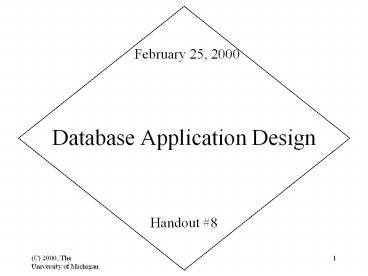Database Application Design - PowerPoint PPT Presentation
1 / 28
Title:
Database Application Design
Description:
Class meets on Fridays, 2:30 - 5:30 PM, 311 WH (C) 2000, The University of Michigan ... {Existing Structure, New Construction}, {California.Children, Nevada}) 20 ... – PowerPoint PPT presentation
Number of Views:21
Avg rating:3.0/5.0
Title: Database Application Design
1
Database Application Design
February 25, 2000
- Handout 8
2
Course information
- Instructor Dragomir R. Radev (radev_at_si.umich.edu)
- Office 305A, West Hall
- Phone (734) 615-5225
- Office hours Thursdays 3-4 and Fridays 1-2
- Course page http//www.si.umich.edu/radev/654w00
- Class meets on Fridays, 230 - 530 PM, 311 WH
3
Managing multi-user databases(contd)
4
Concurrency control
- Lax and strict policies
- Atomic transactions (LUWs logical units of
work) - Example customersalesperson
- Concurrent transaction processing interlocking
- Lost update problem
5
Example
- User B
- Read item 200
- Reduce by 3
- Write item 200
- User A
- Read item 100
- Reduce by 5
- Write item 100
6
Resource locking
- Locks implicit, explicit
- Example two users
7
Example
- User B
- Lock item 100
- Read item 100
- Reduce by 3
- Write item 100
- User A
- Lock item 100
- Read item 100
- Reduce by 5
- Write item 100
8
Example (contd)
- 1. Lock item 100 for A
- 2. Read item 100 for A
- 3. Lock item 100 for B cannot
- 4. Decrease 100 by 5
- 5. Write item 100 for A
- 6. Release As lock on 100
- 7. Lock item 100 for B
- 8. Read item 100 for B
- 9. Decrease item 100 by 3
- 10. Write 100 for B
- 11. Release Bs lock on 100
9
Resource locking
- Serizalizable transaction
- 2PL growing phase, followed by a shrinking phase
- COMMIT and ROLLBACK
- DEADLOCKS
10
Transaction isolation levels
- Exclusive use
- Repeatable read mix of shared and exclusive
locks - Dirty read for reports which dont necessarily
need to contain the latest data
11
Cursor types
- Forward only changes made to earlier records are
hidden - Static any changes are hidden
- Dynamic all changes are visible
12
Database recovery
- Reprocessing uses database saves
- Rollback/Rollforward uses transaction logs,
before-images, and after-images
13
Database security
- Users, groups, permissions, objects
- Permissions
- CONNECT ALTER SESSION, CREATE TABLE, CREATE VIEW
14
Application security
- Usually done on the Web server
- ASP script modifies SQL statement
SELECT FROM EMPLOYEElt WHERE EMPLOYEE.Name
SESSION(EmployeeName)gt
15
Sharing enterprise data
16
Enterprise DB architectures
- Teleprocessing systems
- Client-server systems
- File-sharing systems
- Distributed database systems vertical and
horizontal fragmentation
17
Comparing distributed DB architectures
Unified database
Distributed databases
Single Nonpartitioned Nonreplicated
Partitioned Nonreplicated
Nonpartitioned Replicated
Partitioned Replicated
Increased parallelism
-
Increased independence
-
Increased flexibility
-
Increased availability
-
Increased cost/complexity
Increased difficulty of control
Increased security risk
18
Problems in downloaded databases
- Coordination
- Consistency
- Access control
- Computer crime
19
On Line Analytic Processing (OLAP)
- Hypercubes, axes, dimensions, slices
- Values of a dimension are called members
- Levels hierarchical organization e.g., date,
month, year - CROSSJOIN (Existing Structure, New
Construction, California.Children, Nevada)
20
OLAP SQL
CREATE CUBE HousingSalesCube ( DIMENSION Time
TYPE TIME, LEVEL Year TYPE YEAR,
LEVEL Quarter TYPE QUARTER, LEVEL Month
TYPE MONTH, DIMENSION Location, LEVEL
USA TYPE ALL, LEVEL State, LEVEL
City, DIMENSION HousingCategory, DIMENSION
HousingType, MEASURE SalesPrice,
FUNCTION AVG, MEASURE AskingPrice,
FUNCTION AVG)
21
KDD Data Mining
22
Association rules
- X ?Y
- 65 of all customers who buy beer and tomato
sauce also buy pasta and chicken wings - Support (X)
- Confidence (X ? Y) Support(XY) / Support (X)
23
Object-oriented data processing
24
Introduction
- OOP objects encapsulated structures with
attributes and methods - Interface implementation
- Inheritance
- Polymorphism
- Transient and persistent objects
25
Final project guidelines
26
Checklist
IntroductionUser interviews/needs table,
reports, queries, formsInitial data modelER
modelDecompositionSQL codeDocumentationEvaluat
ion, Future workScheduleSustainabilitySnapshots
PresentationDemo
27
Grading
- Project 40- design 10- implementation 10-
documentation 10- presentationdemo 10
28
Readings for next time
- Kroenke
- Chapter 14 Sharing Enterprise Data
- Chapter 17 Object-Oriented Database Processing
- YRK (optional)
- Chapter 14 Java and JDBC































